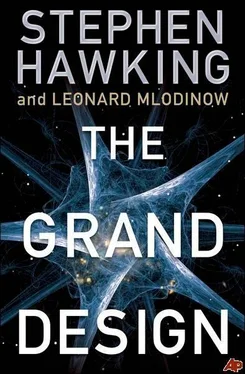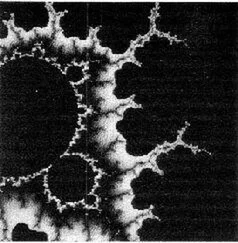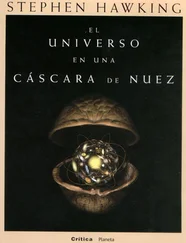The next aspects of the universe for which a law or model was discovered were the electric and magnetic forces. These behave like gravity, with the important difference that two electric charges or two magnets of the same kind repel each other, while unlike charges or unlike magnets attract. Electric and magnetic forces are far stronger than gravity, but we don’t usually notice them in everyday life because a macroscopic body contains almost equal numbers of positive and negative electrical charges. This means that the electric and magnetic forces between two macroscopic bodies nearly cancel each other out, unlike the gravitational forces, which all add up.
Our current ideas about electricity and magnetism were developed over a period of about a hundred years from the mid-eighteenth to the mid-nineteenth century, when physicists in several countries made detailed experimental studies of electric and magnetic forces. One of the most important discoveries was that electrical and magnetic forces are related: A moving electrical charge causes a force on magnets, and a moving magnet causes a force on electrical charges. The first to realize there was some connection was Danish physicist Hans Christian Ørsted. While setting up for a lecture he was to give at the university in 1820, Ørsted noticed that the electric current from the battery he was using deflected a nearby compass needle. He soon realized that moving electricity created a magnetic force, and coined the term “electromagnetism.” A few years later British scientist Michael Faraday reasoned that-expressed in modern terms-if an electric current could cause a magnetic field, a magnetic field should be able to produce an electric current. He demonstrated that effect in 1831. Fourteen years later Faraday also discovered a connection between electromagnetism and light when he showed that intense magnetism can affect the nature of polarized light.
Faraday had little formal education. He had been born into a poor blacksmith’s family near London and left school at age thirteen to work as an errand boy and bookbinder in a bookshop. There, over the years, he learned science by reading the books he was supposed to care for, and by performing simple and cheap experiments in his spare time. Eventually he obtained work as an assistant in the laboratory of the great chemist Sir Humphry Davy. Faraday would stay on for the remaining forty-five years of his life and, after Davy’s death, succeed him. Faraday had trouble with mathematics and never learned much of it, so it was a struggle for him to conceive a theoretical picture of the odd electromagnetic phenomena he observed in his laboratory. Nevertheless, he did.
One of Faraday’s greatest intellectual innovations was the idea of force fields. These days, thanks to books and movies about bug-eyed aliens and their starships, most people are familiar with the term, so maybe he should get a royalty. But in the centuries between Newton and Faraday one of the great mysteries of physics was that its laws seemed to indicate that forces act across the empty space that separates interacting objects. Faraday didn’t like that. He believed that to move an object, something has to come in contact with it. And so he imagined the space between electric charges and magnets as being filled with invisible tubes that physically do the pushing and pulling. Faraday called those tubes a force field. A good way to visualize a force field is to perform the schoolroom demonstration in which a glass plate is placed over a bar magnet and iron filings spread on the glass. With a few taps to overcome friction, the filings move as if nudged by an unseen power and arrange themselves in a pattern of arcs stretching from one pole of the magnet to the other. That pattern is a map of the unseen magnetic force that permeates space. Today we believe that all forces are transmitted by fields, so it is an important concept in modern physics-as well as science fiction.
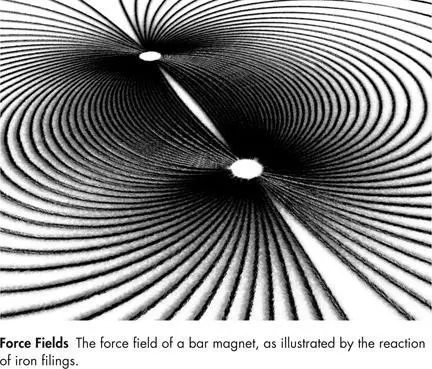
For several decades our understanding of electromagnetism remained stalled, amounting to no more than the knowledge of a few empirical laws: the hint that electricity and magnetism were closely, if mysteriously, related; the notion that they had some sort of connection to light; and the embryonic concept of fields. At least eleven theories of electromagnetism existed, every one of them flawed. Then, over a period of years in the 1860s, Scottish physicist James Clerk Maxwell developed Faraday’s thinking into a mathematical framework that explained the intimate and mysterious relation among electricity, magnetism, and light. The result was a set of equations describing both electric and magnetic forces as manifestations of the same physical entity, the electromagnetic field. Maxwell had unified electricity and magnetism into one force. Moreover, he showed that electromagnetic fields could propagate through space as a wave. The speed of that wave is governed by a number that appeared in his equations, which he calculated from experimental data that had been measured a few years earlier. To his astonishment the speed he calculated equaled the speed of light, which was then known experimentally to an accuracy of 1 percent. He had discovered that light itself is an electromagnetic wave!
Today the equations that describe electric and magnetic fields are called Maxwell’s equations. Few people have heard of them, but they are probably the most commercially important equations we know. Not only do they govern the working of everything from household appliances to computers, but they also describe waves other than light, such as microwaves, radio waves, infrared light, and X-rays. All of these differ from visible light in only one respect-their wavelength. Radio waves have wavelengths of a meter or more, while visible light has a wavelength of a few ten-millionths of a meter, and X-rays a wavelength shorter than a hundred-millionth of a meter. Our sun radiates at all wavelengths, but its radiation is most intense in the wavelengths that are visible to us. It’s probably no accident that the wavelengths we are able to see with the naked eye are those in which the sun radiates most strongly: It’s likely that our eyes evolved with the ability to detect electromagnetic radiation in that range precisely because that is the range of radiation most available to them. If we ever run into beings from other planets, they will probably have the ability to “see” radiation at whatever wavelengths their own sun emits most strongly, modulated by factors such as the light-blocking characteristics of the dust and gases in their planet’s atmosphere. So aliens who evolved in the presence of X-rays might have a nice career in airport security.
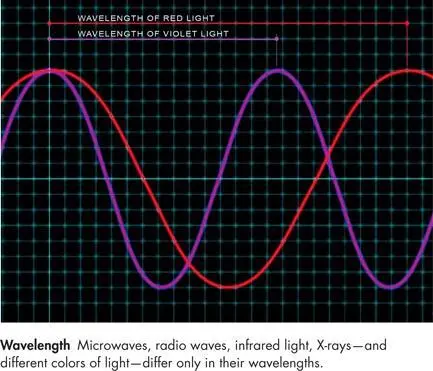
Maxwell’s equations dictate that electromagnetic waves travel at a speed of about 300,000 kilometers a second, or about 670 million miles per hour. But to quote a speed means nothing unless you specify a frame of reference relative to which the speed is measured. That’s not something you usually need to think about in everyday life. When a speed limit sign reads 60 miles per hour, it is understood that your speed is measured relative to the road and not the black hole at the center of the Milky Way. But even in everyday life there are occasions in which you have to take into account reference frames. For example, if you carry a cup of tea up the aisle of a jet plane in flight, you might say your speed is 2 miles per hour. Someone on the ground, however, might say you were moving at 572 miles per hour. Lest you think that one or the other of those observers has a better claim to the truth, keep in mind that because the earth orbits the sun, someone watching you from the surface of that heavenly body would disagree with both and say you are moving at about 18 miles per second, not to mention envying your air-conditioning. In light of such disagreements, when Maxwell claimed to have discovered the “speed of light” popping out of his equations, the natural question was, what is the speed of light in Maxwell’s equations measured relative to?
Читать дальше
